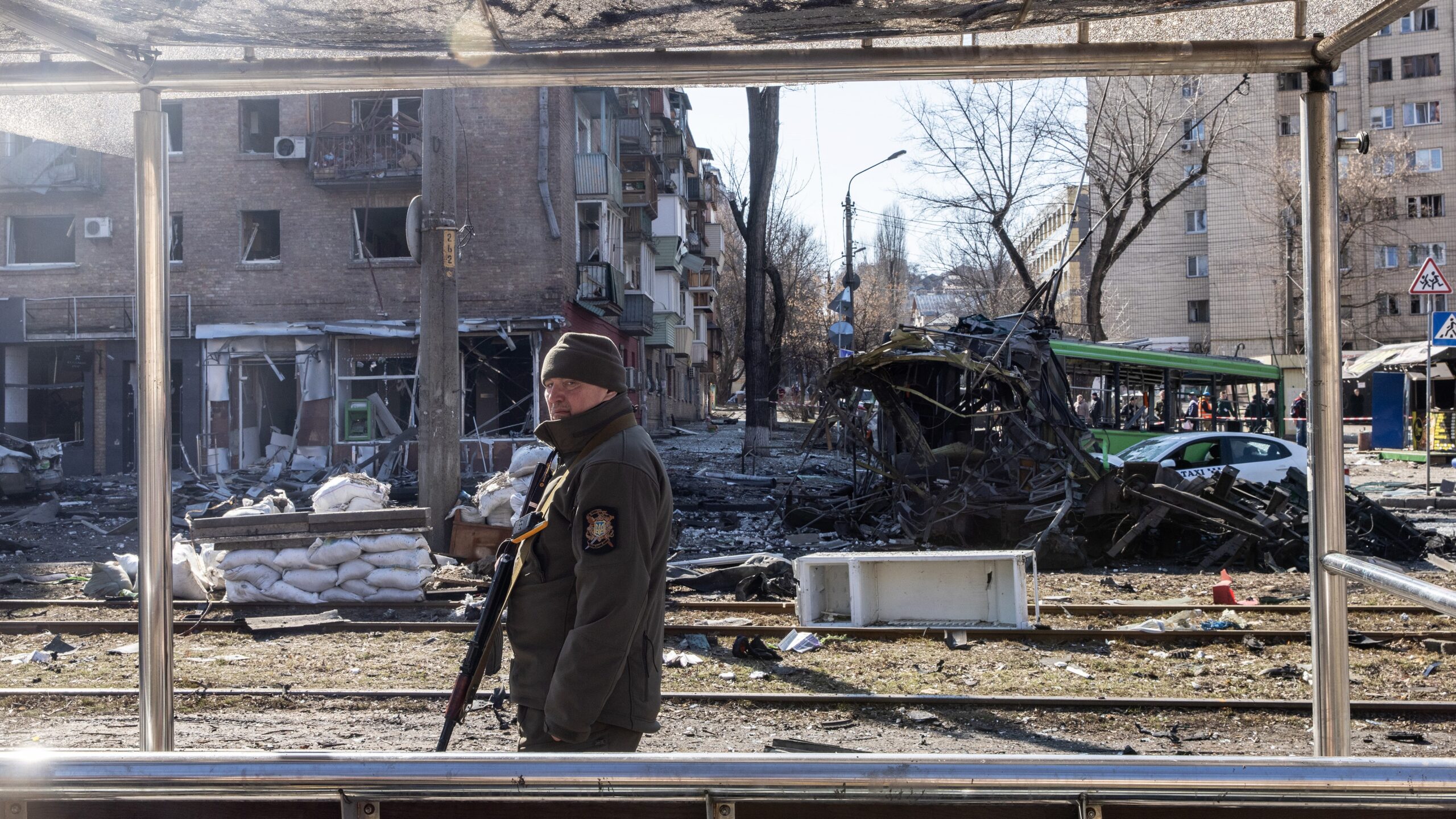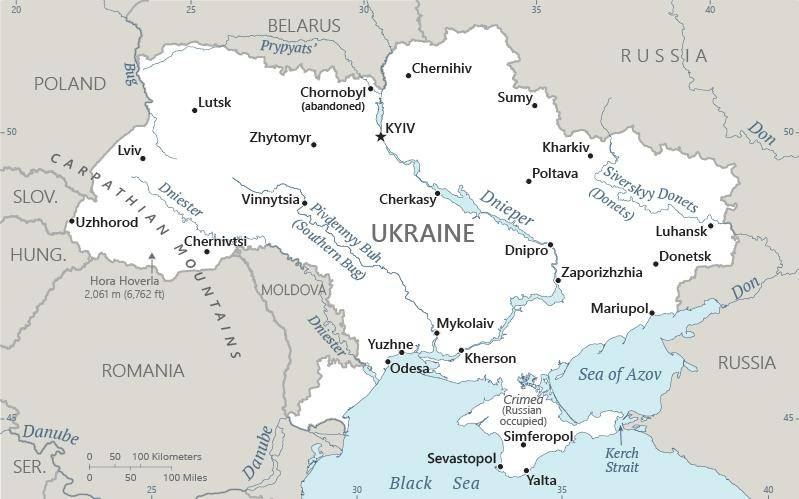
A member of the Ukrainian military stands amid debris from a damaged residential apartment block caused after a Russian rocket in Kyiv, Ukraine. (Chris McGrath/Getty Images)
This is the first in a series of regular analysis pieces by deputy editor Sydney Freedberg.
Russia’s invasion of Ukraine has largely ground to a halt, with Moscow publicly downscaling its objectives, Kyiv staging local counterattacks, and the two governments engaging in direct peace talks. Now what?
Best case, Russian President Vladimir Putin takes his territorial gains so far as a pretext to declare victory and a ceasefire that gives his battered military a reprieve. But even this least-worst-case scenario would leave a crescent-shaped swath of eastern Ukraine in Russian hands, indefinitely. And even if Volodymyr Zelensky’s government accepts a ceasefire, Ukrainian irregulars may well keep fighting that Russian occupation, as long as it lasts. Whatever happens in the coming weeks, the US and its Western allies need to be committed to training and arming Ukraine for the long haul.
To understand just how stubborn Ukrainian resistance can be, just look the last conventional war on Ukrainian soil and its insurgent aftermath, over 60 years ago. During World War II, Ukrainian partisans fought both the Nazis and the Soviets, taking on impossible odds. Even after the Soviets reclaimed Ukraine, insurgents kept fighting in some places well into the 1950s.
For more on the Ukraine crisis, click here.
This was a resistance dependent on popular support from Ukrainians who had no experience of living in an independent state — except, arguably, a few months of a German-backed “hetmanate” in 1918 — and who were conditioned to obey by almost three centuries of rule from Moscow. This was a resistance with no outside support, up against a superpower at its Stalinist peak. It is hard to imagine more unfavorable circumstances for an insurgency — yet one endured for a decade.
By contrast, today’s Ukrainians have all the institutions of a nation-state and the experience of over 30 years of independence, enough time for an entire generation to grow up with the idea. Civilians are staging protests in Russian-occupied cities, making Molotov cocktails, and flocking to join the hastily trained Territorial Defense Forces. The country is increasingly awash in weapons, including sophisticated anti-tank and anti-aircraft missiles provided by the West. Meanwhile, Russia’s strength is a shadow of its Soviet self.
Worse, in that weakness, Russia has resorted to indiscriminate bombardments of urban areas that will ensure lasting hatred for the occupiers. Conditions are so conducive to insurgency at this point that, even if Zelensky wanted to stop Ukrainians in Russian-occupied areas from fighting — for example, as part of a peace deal — they might not listen. (That’s assuming any peace deal is ratified; Zelensky has said a nationwide referendum would have to approve any agreement, and after all they have suffered, Ukrainian voters may prefer to fight on against an invader they see already retreating in some places.)
And even if Putin wanted to pull Russian forces out of Ukraine, he couldn’t do so without appearing to admit defeat. Such a blow to his strongman image could get him overthrown or killed. Not that Putin seems to be contemplating major concessions: At the age of 69, he seems to have staked his legacy on undoing what he has called “the greatest geopolitical catastrophe of the 20th century,” the breakup of the Russian-dominated Soviet Union. Both politically and personally, he needs to be able to claim at least some kind of success. But the more of Ukraine he occupies, the more he has to pacify, and the greater the strain on his forces.
Those forces have fallen far short of expectations, with tank columns blundering into ambushes, generals dying in surprising numbers, a 40-mile long convoy stalled for days north of Kyiv, strike aircraft flying in small groups that can’t suppress Ukrainian air defenses, and reported shortfalls of food, fuel, and even the trucks required to carry them. Morale seems poor, with heavy casualties, desertions, and even large-scale surrenders. As Ben Hodges, the retired commander of US Army Europe has argued, Russia seems to be reaching what Clausewitz called the “culminating point” where mounting losses, supply shortages, and sheer exhaustion force an attacker to halt. Across much of the front, the Institute for the Study of War reports, Russian forces have already been digging in and laying mines, distinctly defensive measures.
RELATED: Russia has a military professionalism problem, and it is costing them in Ukraine
That said, Russia still has far more artillery, planes, and armored vehicles. And while Ukrainian light-infantry ambushes have proven devastatingly successful on defense, such tactics don’t translate well to offense. So while Russia can’t conquer all of Ukraine, Ukraine can’t recapture all its lost territory, either.

Source: CIA World Factbook
How much can Russia take?
At a minimum, they can probably hold what they’ve seized already. That would allow Putin to expand the territory controlled by the puppet “people’s republics” he has recognized in the eastern Ukrainian provinces of Donetsk and Luhansk. With that eastern region, the Donbas, now officially the focus of the offensive, Putin’s domestic propaganda machine just might be able to spin this result as a victory justifying all Russia’s sacrifices so far, even though it leaves Ukraine with almost all its major cities.
But Russia is still pushing consistently in one place, a grinding block-by-block advance in the strategic southeastern seaport of Mariupol. The Institute for the Study of War expects the city to fall in “weeks.” Mariupol matters not only because it would be the biggest Ukrainian city to be occupied (about the tenth largest by population): It would also complete the conquest of Ukraine’s southeastern coast, securing a land bridge between Russia proper and the Crimean Peninsula, seized from Ukraine in 2014. That would be a significant, if limited, success for Putin to claim.
It’s also possible that Russia could regroup, learn from its mistakes, and launch a new offensive with greater success — as it did after initial disasters in its 1940 invasion of Finland, for example. (A ceasefire, in this context, would just be an opportunity to prepare for a second round). In that case, the next cities to fall could be Ukraine’s two largest: the capital, Kyiv, and the country’s second city, Kharkiv, both of which are currently on the front line. While Russia has pledged a partial pullback around Kyiv, it may well be simply redeploying forces to the Donbas — and could redeploy them back once Donbas is secure.
Kyiv’s loss would be devastating to the Ukrainians – but pushing beyond it would be difficult for the Russians. The country is peppered with other urban areas to fortify and defend, backed by the natural barrier of the Dnipro (Dneiper) River winding its way through central Ukraine from Kyiv in the north to Kherson in the south. In fact, the first time Russia invaded what is now Ukraine, in the 17th century, it seized the country only up to the Dnipro; Putin is unlikely to repeat that success today.
Yes, legally and morally, the West should accept nothing less than a Ukraine whole and free, within the internationally recognized boundaries Russia itself guaranteed in the 1994 Budapest memorandum. That means refusing to recognize Russian annexations and puppet states carved out of Ukrainian territory, just as we have already refused to recognize the annexation of Crimea and the “independence” of Donetsk and Luhansk.
But strategically and practically, we will probably have to live with a bloodied buffer state in unoccupied Ukraine and a guerrilla resistance in the Russian-occupied territories. Both will need Western support, probably for years to come. That does not mean putting NATO combat troops on Ukrainian soil: The risk of a direct clash with Russia is too great. But it does mean training, advising, and arming whatever remains of free Ukraine — and turning a blind eye when Western-trained personnel and Western munitions turn up in Russian-controlled territory as part of the resistance.
The risk, of course, is that Russia could retaliate. But not supporting Ukraine carries risks of its own. As long as a Ukrainian state exists, even if only west of the Dnipro, it stands as a buffer between Russia and NATO territory; if Ukraine falls, Russian forces can reach the borders of three previously unthreatened NATO allies — Slovakia, Hungary, and Romania – and open a potential southeastern invasion route into Poland, which is already exposed via Kaliningrad and Belarus in the northeast. As long as Ukrainian resistance persists in Russian-occupied territory, it bogs down Russian forces; if resistance fails, those forces are freed up to attack elsewhere.
Let’s be clear: Anything that prolongs the fighting in Ukraine prolongs the agony of the Ukrainian people. But they have already made the hard choice to resist, and their sufferings are a shield for the rest of Europe. The US and its NATO allies need to make that shield as strong as possible.
Senate passes $95 billion foreign aid bill, as DoD eyes next Ukraine weapons package
Additional aid for Ukraine could be made available “within days” said Pentagon Press Secretary Maj. Gen. Pat Ryder earlier today.


























